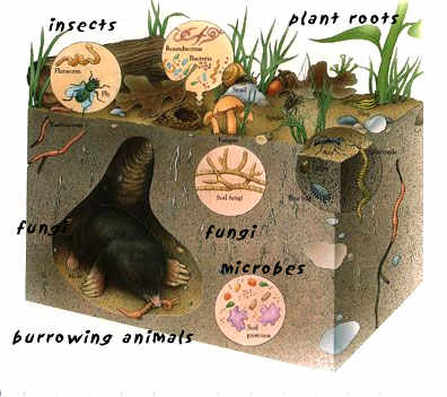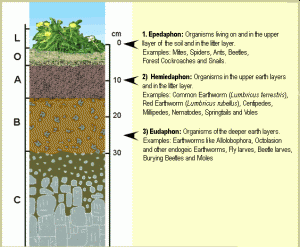Organically Grown, Fresh Produce from Living Earth Farms!
FEED THE SOIL, LET THE SOIL FEED YOUR PLANTS.

Modern agriculture tends to look at the soil as an inert media to be used to supply artificial fertilizers, herbicides and pesticides to the growing crops. Nothing could be further from the truth. The soil is a living organism composed of countless living things working with nature to form the cycle of growth, decay and regrowth which builds soil fertility and promotes healthy plant growth.
Soil covers a large portion of the earth. It supports living things directly or indirectly. Soil as many would define it as dirt, also consists of four main components which makes a life of a plant possible: Minerals, air, water and organic matter are the main components of all soils. Soil rich in these components provide a huge contribution to agricultural businesses and to human beings. It has been determined that there are about 50 billion microbes in 1 tablespoon of soil. The following chart describes the estimated number of organism in each gram of soil. These living organisms are the key to transforming the inert components of the soil into nutrients which can be used by the living plant.
| Bacteria | 3,000,000 to 500,000,000 |
| Actinnomycetes | 1,000,000 to 20,000,000 |
| Fungi | 5,000 to 1,000,000 |
| Yeast | 1,000 to 1,000,000 |
| Protozoa | 1,000 to 500,000 |
| Algae | 1,000 to 500,000 |
| Nematodes | 10 to 5,000 |
Chart Credit to Craig Mckintosh
The formation of soil varies directly by the weather, time, matter and topography. It is itself very complex. There are different textures of soil, the sand, silt and clay. The soil texture depends upon the type, the quantity and the distribution of the minerals in the land. The topmost layer of the soil contains humus and microorganisms which gives life to all living things because it is in this layer,these microorganisms work to allow the nutrients to become available to the plants plants. The humus controls and regulates functions of the soil, in it depends the yield of the crop; the abundance of the harvest and the nutrients that we can acquire from its fruits.
As soil life forms move through the soil they create channels that improve aeration and drainage. Nematodes and protozoa swim in the film of water around soil particles and feed on bacteria. Mites eat fungi; fungi decompose soil organic matter. The microorganisms’ primary role is to break down organic matter to obtain energy. They help release essential nutrients and carbon dioxide, perform key roles in nitrogen fixation, the nitrogen and phosphorus cycles, denitrification, immobilization and mineralization. Microbes must have a constant supply of organic matter or their numbers will decline. Conditions that favor soil life also promotes plant growth.
When the soil is tilled and left bare, soil life can be injured by high temperatures. To promote soil organisms; incorporate organic matter such as leaves, compost or other organic materials, till as little as possible, minimize soil compaction, maintain favorable soil pH and fertility, and use an organic mulch on the soil surface.
Nature’s formative and reproductive processes are extremely subtle, and are based on a delicate, easily upset balance in the intermixture of energies and materials on which they are founded. In our failure either to understand or perceive them and the pursuit of profit above all else, however, we have literally trodden them into the ground. Yet this is the same ground which is supposed to sustain and nourish us, and from which life itself evolves. The time has come for a long overdue and urgent reappraisal of what we are doing; indeed it has now become the imperative of the hour; more particularly, in terms of the fundamentals of forestry and agriculture. Instead of the former vibrant luxuriance of natural forests, where one species fosters the growth and development of another, in today’s plantation forests, monocultures of single species of the same age are forced to compete with one another for their necessities of life.
In other words, competition, with all its negative consequences, has been introduced into a long-standing, integrated harmony where it never existed before. Instead of smaller acreages and holdings, where produce was fertilised largely organically and crops were religiously rotated, in modern agri-businesses carbon dioxide- trapping hedgerows were swept away and crops are grown without rotation on an increasingly barren soil. These have to be propped up with artificial fertiliser, which ultimately destroys the soil and its micro-organisms.

http://www.livingsoil.co.uk/learning/soilsustain.htm
http://cwmi.css.cornell.edu/vermicompost.htm
http://www.motherearthnews.com
http://garden.lovetoknow.com/wiki/Organic_
http://www.nature.com/news/1998/981126/full/news981126-3.html


